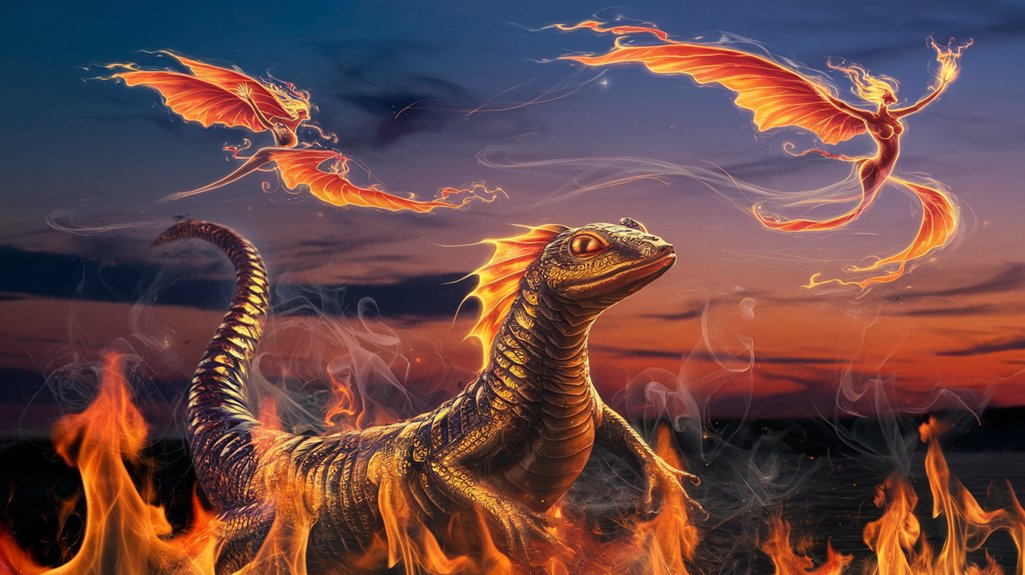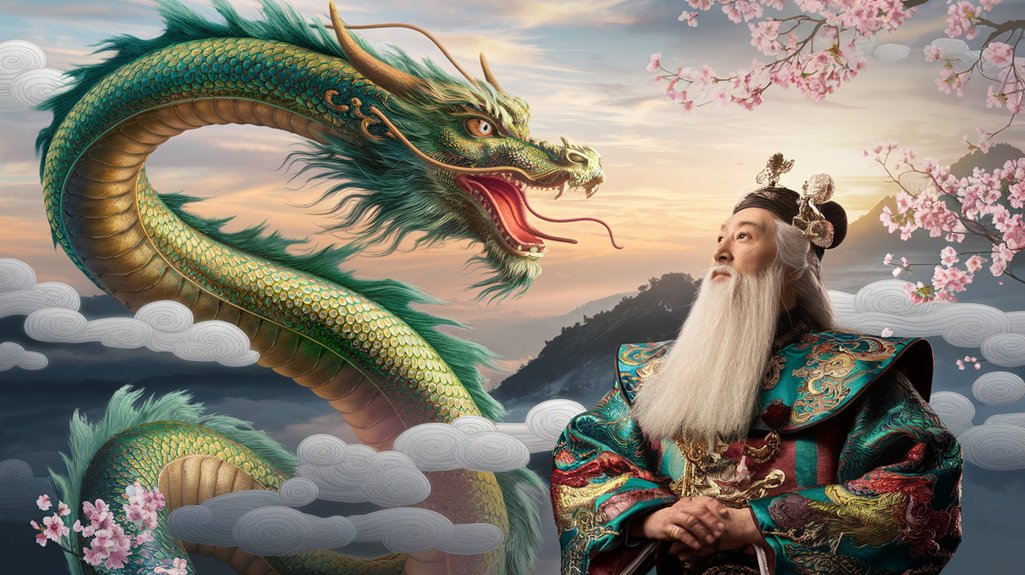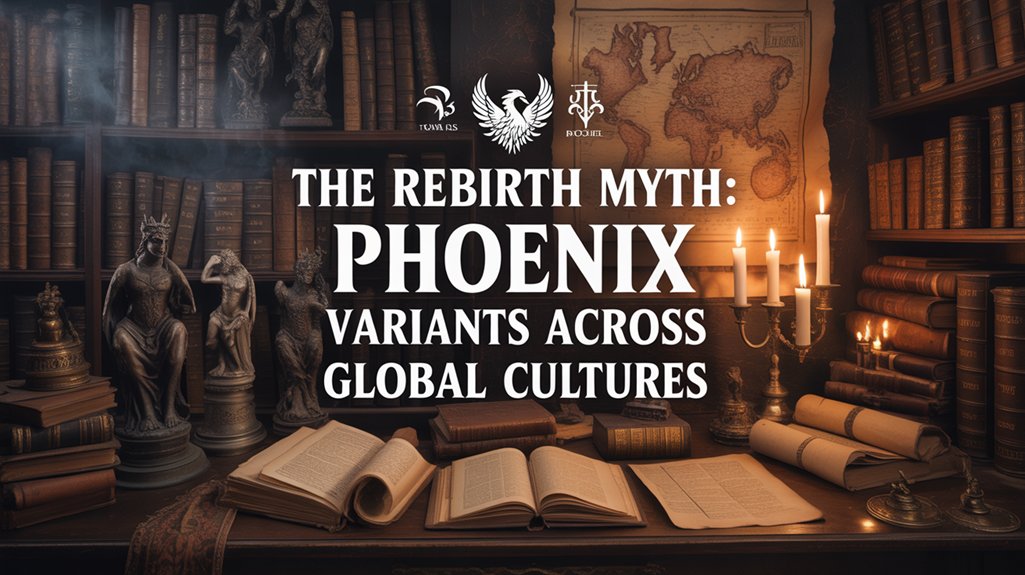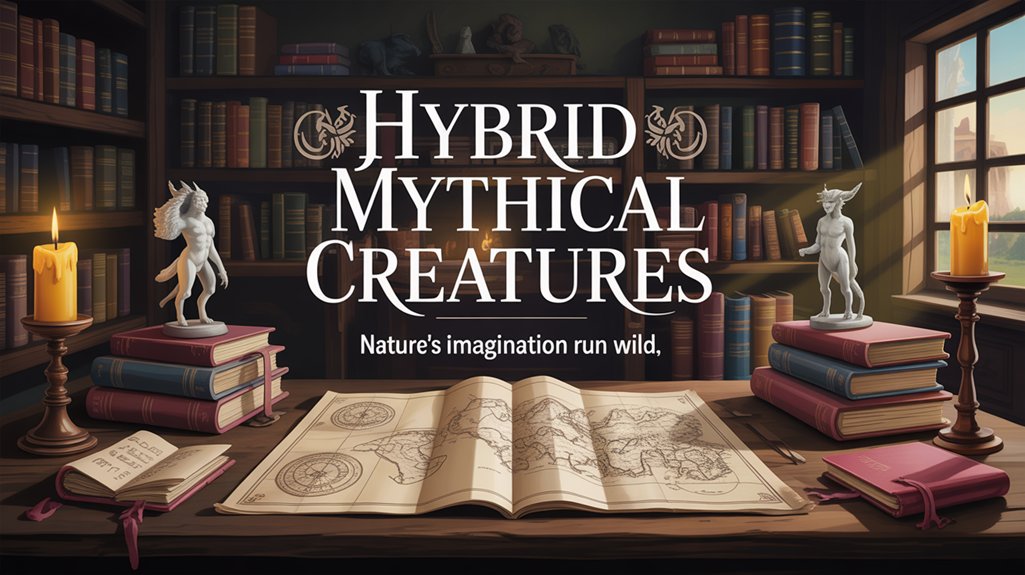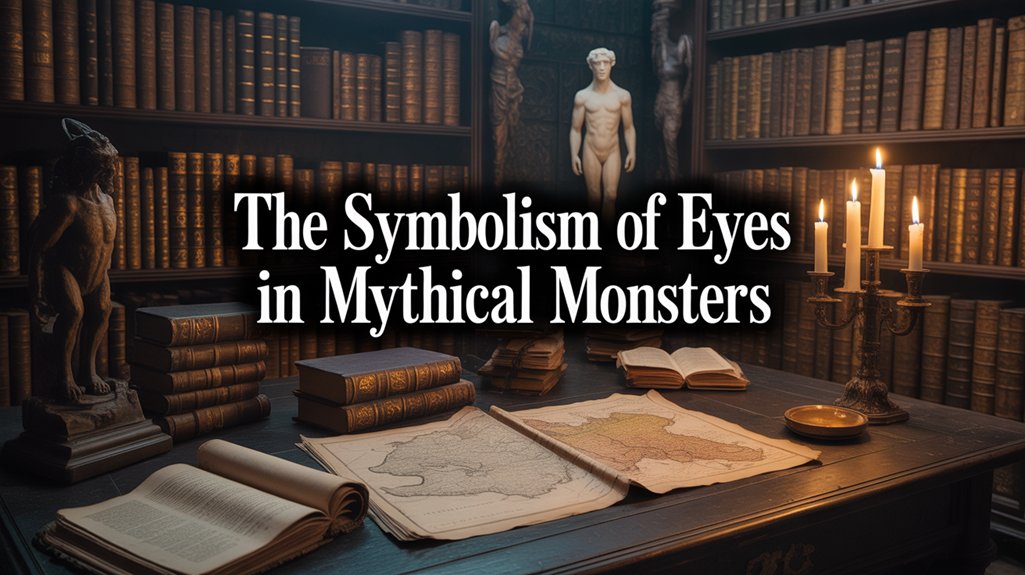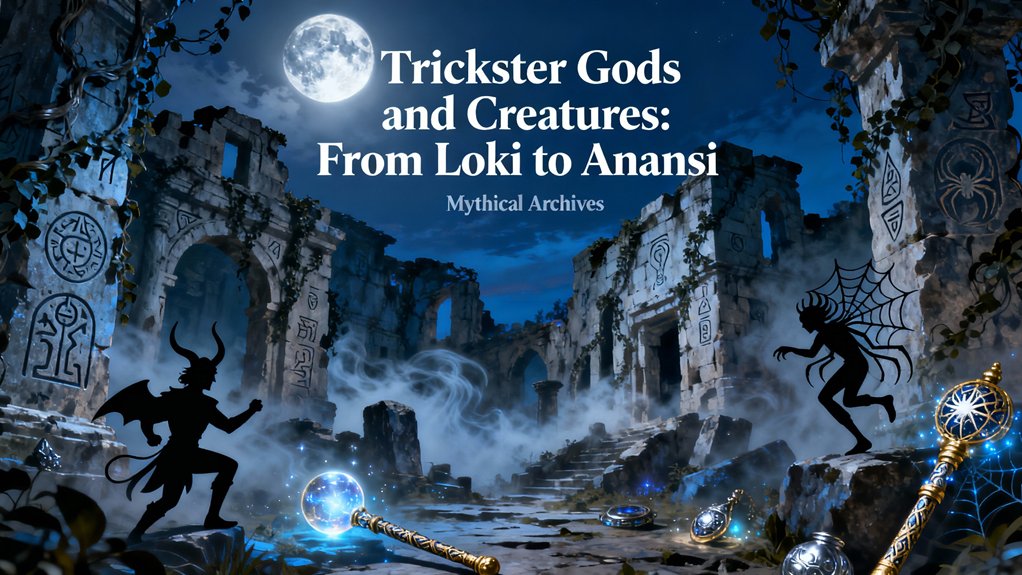
Trickster figures—from Norse Loki’s shapeshifting chaos to West African Anansi’s web-spinning cunning—emerge across every human culture as liminal entities dwelling between order and disruption. You’ll find these boundary-crossers in Indigenous Coyote’s creative destruction, Yoruba Eshu’s crossroads power, Chinese Sun Wukong’s celestial rebellion, and Pacific Northwest Raven’s paradoxical theft of sunlight. They embody humanity’s shadow-self: the instinctive recognition that change demands transgression, that wisdom often arrives through chaos. These archetypal disruptors continue manifesting in contemporary narratives, their ancient psychological architecture revealing why certain mythological patterns persist across millennia and geography.
Table of Contents
ToggleKey Takeaways
- Trickster figures appear across cultures worldwide, embodying chaos, transformation, and defiance of authority through characters like Loki, Anansi, and Coyote.
- Loki, the Norse trickster, shapeshifts through multiple forms and transitions from mischievous god to architect of cosmic destruction during Ragnarök.
- Anansi, the West African spider god, uses cunning and intellect to challenge hierarchies and preserve ancestral wisdom through storytelling.
- Tricksters operate in liminal spaces between order and chaos, serving as both creators and destroyers who facilitate necessary transformation.
- These figures represent the human shadow-self, teaching that wisdom often emerges through disruption and transgression of rigid social structures.
The Universal Appeal of Trickster Figures Across Mythology
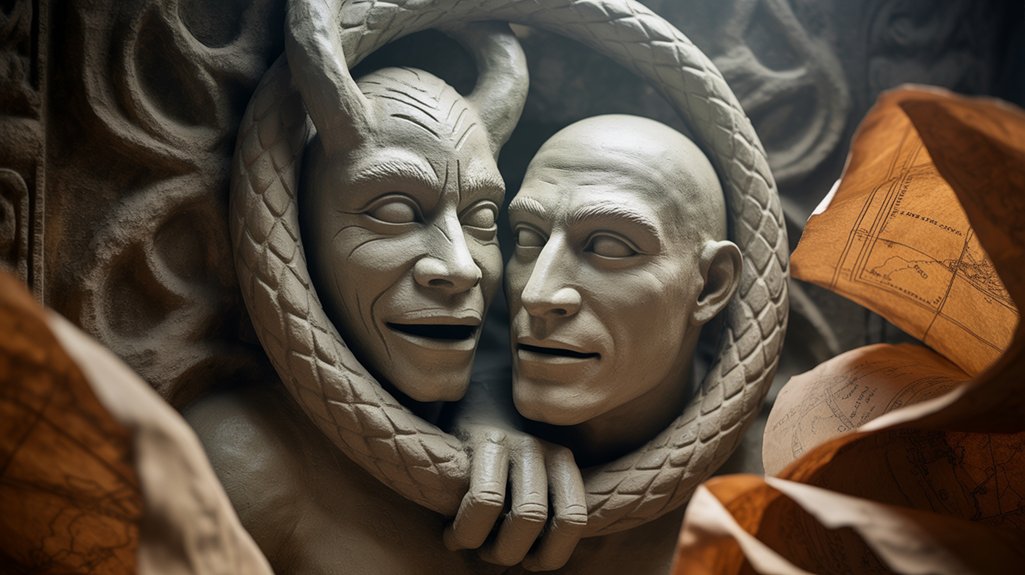
Though they emerge from disparate corners of the world—from the frost-bitten reaches of Norse Scandinavia to the sun-scorched savannas of West Africa—trickster figures share an uncanny constellation of traits that transcends geographical and temporal boundaries.
🎯 Recommended Products
Handpicked items related to this article:
As an Amazon Associate, we earn from qualifying purchases.
You’ll find these chimeric entities defying authority, breaking cosmic laws, shape-shifting through realities. They speak to something fundamental in your psyche.
Their cultural significance runs deeper than mere entertainment. These figures map onto psychological archetypes that Jung identified as essential to human consciousness—the shadow-self that questions, disrupts, alters.
You recognize them instinctively: Loki weaving deception among the Aesir, Anansi spinning webs of cunning across Akan cosmology, Coyote dancing through Indigenous North American traditions.
They embody your desire for freedom from rigid structures. Eldritch and unpredictable, they operate in liminal spaces where rules dissolve, where change becomes possible.
Through their transgressive acts, you glimpse liberation—the eternal human hunger to transcend boundaries imposed by gods and mortals alike.
Loki: Norse Mythology’s Master of Chaos and Transformation
You’ll find in Loki a figure whose metamorphic essence transcends mere illusion—his chimeric alterations into mare, salmon, and fly reveal a being who exists beyond fixed categories, a liminal entity whose very nature threatens the ordered cosmos of Asgard.
His betrayals, culminating in the orchestration of Baldr’s death through mistletoe and shadow, earned him a punishment as visceral as it was eternal: bound beneath a serpent whose venom seared his flesh until the world’s ending.
When Ragnarök’s apocalyptic fires consume the Nine Domains, this shackled trickster shall break free to lead the jötnar against the gods, fulfilling his destiny as both catalyst and herald of cosmic dissolution.
Within the pantheon alongside Odin, Thor, and Freya, Loki embodied the tension between order and chaos that defined the Viking worldview, where strife and unfairness were acknowledged as inherent features of existence rather than aberrations to be denied.
Loki’s Shapeshifting Abilities Explained
Among the pantheon of Norse deities, Loki stands unrivaled in his mastery of corporeal alteration—a power that transcends mere illusion to achieve genuine biological change. Loki’s modifications represent humanity’s ancient recognition of identity’s fluid nature, manifesting through salmon, mare, seal, and falcon forms. These shapeshifting myths embody liberation from physical constraints.
| Form Assumed | Purpose of Modification | Mythological Consequence |
|---|---|---|
| Mare | Distract Svaðilfari | Birth of Sleipnir |
| Salmon | Escape divine wrath | Captured by Æsir |
| Falcon | Retrieve Iðunn | Restoration of youth |
| Seal | Contest with Heimdallr | Battle for Brísingamen |
| Old Woman | Prevent Baldr’s return | Permanent death sealed |
Such chimeric capabilities weren’t merely theatrical—they represented genuine transformation. You witness how Loki’s eldritch abilities challenged Norse cosmological boundaries, demonstrating that freedom exists beyond predetermined forms. While Greek mythology also features shapeshifting deities, the Theoi Project catalogs these transformations through classical literature quotations rather than analytical interpretation of their deeper meanings.
Betrayals and Bound Punishment
When Loki orchestrated Baldr’s death through calculated deception—guiding the blind god Höðr’s hand to hurl mistletoe at the beloved deity—he transgressed beyond redemption, shattering the delicate equilibrium between acceptable chaos and unforgivable treachery.
The Æsir’s response embodied ancient betrayal consequences: binding the trickster beneath a venomous serpent, whose poison dripped ceaselessly upon his face. His faithful wife Sigyn holds a bowl to catch the venom, but when she must empty it, the drops burn through divine flesh.
Loki writhes. The earth trembles—earthquakes manifest his agony. This punishment myth demonstrates how societies codify their deepest fears about transgression, altering abstract concepts of justice into visceral, eternal suffering.
You witness here the price of freedom without responsibility, autonomy divorced from consequence.
Ragnarok’s Chaotic Herald
Bound torment stretches across ages, yet bondage never truly contains chaos—it merely postpones its eruption.
You’ll find Loki’s prophesied release marks Ragnarok’s commencement, where the trickster evolves into apocalypse’s architect. His chains dissolve when the world-tree Yggdrasil trembles, when Fenrir’s jaws snap wide to swallow Odin himself.
Ragnarok’s symbolism reveals chaos as neither evil nor good—simply inevitable evolution, cosmic renewal through destruction. You witness chaotic changes manifesting: the bound jester becomes warrior-herald, leading frost giants and eldritch horrors against Asgard’s golden halls.
His chimeric offspring—serpent, wolf, death-goddess—join this cataclysmic procession. The trickster’s ultimate act embodies freedom’s terrible price: total annihilation preceding rebirth.
Here chaos serves its primordial function, breaking stagnant order so new worlds might emerge from smoking ruins.
Anansi: The West African Spider Who Spun Tales and Tricks
Across the verdant expanses of West Africa, from the Ashanti kingdoms of Ghana to the Akan peoples scattered throughout the coastal regions, one figure weaves through oral tradition with unparalleled cunning—Anansi, the spider deity whose eight legs carry the weight of creation myths, moral lessons, and subversive wisdom.
You’ll find Anansi’s wisdom embedded in narratives that challenge hierarchies, where the small triumph over the mighty through intellect rather than force. This arachnid trickster purchased the world’s tales from Nyame, the sky god, by capturing four impossible creatures: python, leopard, hornet, and fairy. Payment rendered.
Anansi’s stories traveled across the Middle Passage, evolving into Aunt Nancy in the American South, becoming tools of resistance for enslaved peoples who recognized their own predicament in the spider’s cunning survival. His web connects cosmological creation to everyday rebellion, demonstrating how narrative itself becomes eldritch power—shaping reality through spoken word, preserving ancestral knowledge within seemingly simple folktales that carry transformative potential.
Coyote: The Shape-Shifting Trickster of Native American Traditions
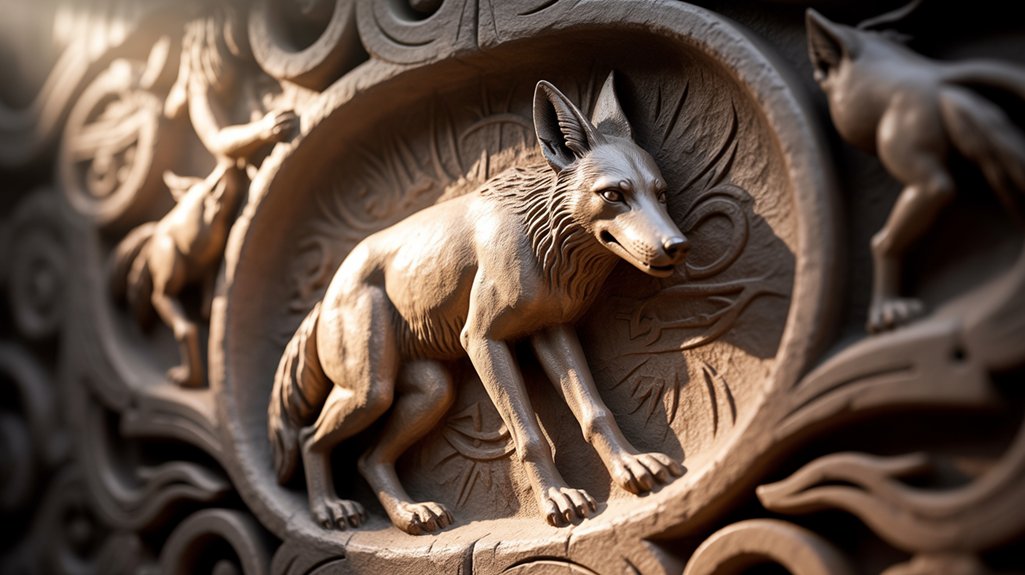
You encounter Coyote across the vast territories of Indigenous North America—from the Plateau peoples to the Southwest nations, from California’s coastal tribes to the Great Plains—where this chimeric figure embodies a paradox that defies European categorical thinking: creator and destroyer, culture hero and fool, sacred teacher and profane glutton merged into one eldritch presence.
His shape-shifting nature reflects the very essence of alteration itself, that fundamental force which Indigenous philosophies recognize as the universe’s primary characteristic, making him simultaneously dangerous and necessary to cosmic order.
The tales you’ll examine—Coyote stealing fire for humanity, Coyote scattering the stars, Coyote’s reckless appetites bringing death into the world—reveal how Indigenous oral traditions wielded this trickster to navigate moral complexity, teaching listeners that wisdom and foolishness, creation and chaos, exist not as opposites but as interwoven threads in existence’s fabric.
Coyote’s Dual Nature Explored
While Western scholarship often attempts to categorize Coyote as either hero or villain, such binary frameworks collapse entirely when confronted with this figure’s fundamental liminality—a being who exists simultaneously as creator and destroyer, benefactor and fool, sacred teacher and profane buffoon.
You’ll discover that Coyote’s wisdom emerges through chaos itself, teaching cosmic truths through deliberately foolish actions that shatter conventional understanding. His chimeric essence defies containment.
Coyote’s mischief isn’t mere entertainment—it’s pedagogical disruption, forcing communities to examine rigid beliefs and recognize reality’s fluid boundaries. Among Plains and Plateau peoples, his eldritch alterations reveal that knowledge arrives through unexpected channels, that liberation demands embracing contradiction.
He embodies the eternal truth: authentic freedom requires accepting paradox, dwelling comfortably within uncertainty’s wild terrain.
Famous Tales and Lessons
Among the most pedagogically potent narratives stands “Coyote Steals Fire,” a tale recorded in variant forms across dozens of tribal nations—the Karuk version alone dates to documented oral traditions predating 1850, though its origins stretch into immemorial antiquity.
You’ll find within this theft-myth the essential paradox of trickster archetypes: transgression births civilization. Coyote’s larceny liberates humanity from darkness, yet his methods remain chimeric, shifting between heroism and chaos.
The cultural significance resonates beyond mere entertainment—these narratives encode survival wisdom, teaching you that adaptation trumps rigidity, that cunning preserves what strength cannot.
Each iteration carries eldritch weight, transmitted through generations as both warning and inspiration. Freedom demands risk. The trickster knows this truth intimately, dwelling eternally in that liminal space where rules bend.
Hermes and Mercury: Divine Messengers With a Mischievous Streak
Through the marble corridors of Olympus and across Roman forums alike, one divine figure embodied contradiction itself—the fleet-footed psychopomp who shepherded souls to the underworld while simultaneously stealing Apollo’s cattle on his first day of existence.
Contradiction incarnate: the divine messenger who shepherded the dead while thieving celestial cattle—guardian and transgressor unified.
You’ll find Hermes (Greek) and his Roman counterpart Mercury occupying liminal thresholds between mortal and divine domains, their caduceus staff marking them as masters of divine communication.
These messenger deities transcended simple courier duties; they manipulated boundaries, blurred ethical lines, and rewrote cosmic rules through calculated mythological mischief.
Their trickster nature manifested immediately—infant Hermes crafted the first lyre from tortoise shell, then bartered it for forgiveness after his bovine theft.
Commerce, thievery, eloquence, travelers: all fell under his purview. He guided souls through eldritch passages to Hades, yet protected merchants conducting earthly transactions.
You witness here the archetype of sanctioned transgression—gods who challenged divine order while maintaining their celestial standing, proving that chaos and authority need not remain separate.
Eshu and Elegba: Yoruba Tricksters at the Crossroads of Fate

Where Hermes traversed Mediterranean landscapes with winged sandals, the Yoruba oricha Eshu (also rendered Elegba, Eleggua, or Exu across diaspora traditions) commands the crossroads themselves—those consecrated intersections where human intention collides with divine will.
You’ll find no simple trickster here. Eshu’s duality manifests as both opener and closer of paths, the divine linguist who translates prayers into forms the orichas comprehend. At Elegba’s crossroads, mortals confront choice stripped of pretense—he tests your sincerity, reveals your contradictions, forces recognition of what you’ve suppressed.
His colors—red and black—signify life’s fundamental tensions: creation and destruction, order and chaos, truth and necessary deception. In Yorubaland and throughout Atlantic diaspora communities, devotees place offerings at literal crossroads, acknowledging his primacy.
Without Eshu’s permission, no spiritual work proceeds. He doesn’t grant freedom; he compels you to claim it through conscious choice, through accepting responsibility for every threshold you cross.
Sun Wukong: The Monkey King’s Rebellion Against Heaven
Born from stone atop the Mountain of Flowers and Fruit, Sun Wukong emerges as tricksterdom incarnate—not merely mischievous but cosmically insubordinate, a figure whose defiance restructures the celestial hierarchy itself.
The Monkey King’s origins trace to 16th-century China’s *Journey to the West*, yet his essence predates literary codification, dwelling in ancient folk traditions where rebellion becomes spiritual necessity.
You’ll recognize Sun Wukong’s defiance operates on unprecedented scales:
- Immortality theft: consuming peaches of longevity, drinking elixirs meant for gods
- Heavenly vandalism: declaring himself “Great Sage Equal to Heaven” while wreaking havoc across celestial palaces
- Metaphysical insurgency: battling divine armies, forcing Buddha himself to intervene
His alteration from stone to sentient being mirrors your own yearning for liberation from predetermined paths.
Sun Wukong embodies radical autonomy—seventy-two transformations granting infinite possibility. When heaven’s bureaucrats attempted containment, he shattered their cosmic order.
Ultimate freedom demanded ultimate transgression. He represents defiance as sacred act.
Raven: Pacific Northwest’s Creator and Chaos-Bringer
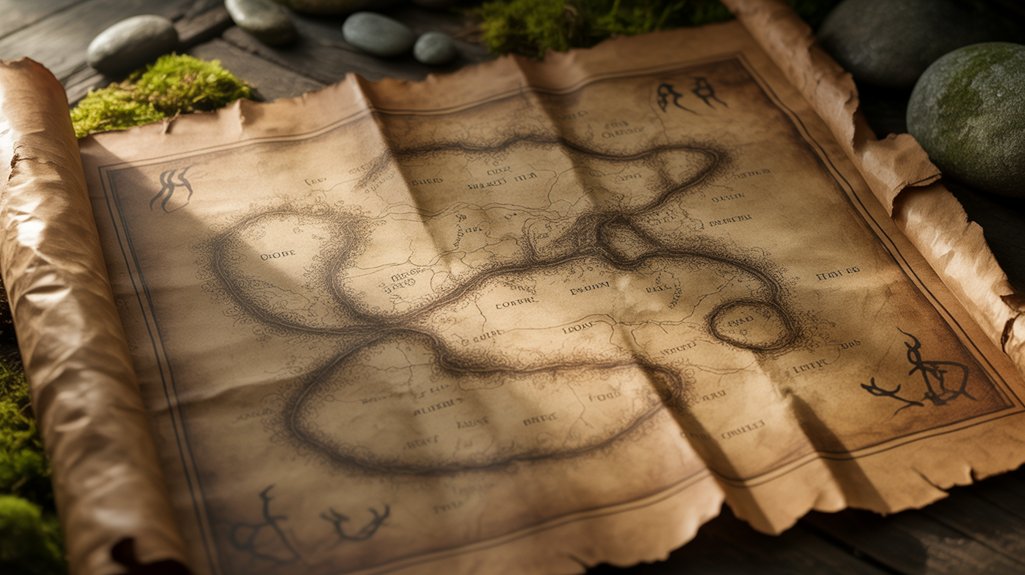
Along the storm-battered coastlines of the Pacific Northwest—from the Tlingit territories of southeastern Alaska through Haida Gwaii to the Salish Sea—Raven materializes as paradox embodied, simultaneously creator and desecrator, culture-bearer and thief.
You’ll discover Raven symbolism woven throughout indigenous oral traditions spanning millennia, this corvid deity stealing sunlight itself to illuminate a darkened world. Creation myths position Raven altering primordial chaos into ordered existence, liberating humanity from clamshell prisons, yet simultaneously disrupting cosmic harmony through insatiable appetite and transgressive desire.
The Cultural significance penetrates beyond mere folklore. Raven exists as chimeric force—neither wholly benevolent nor malevolent—teaching that freedom demands calculated risk, that change requires destruction’s catalyst.
These Chaos narratives reveal eldritch wisdom: you can’t separate order from disorder, enlightenment from deception. Raven’s black wings span contradictions, demonstrating how trickster consciousness operates outside conventional morality.
Here dwells authentic liberation—messy, uncomfortable, necessary. The stories persist because they acknowledge what civilized thought denies: progress births from transgression.
The Enduring Legacy of Tricksters in Modern Culture
Though ancient trickster narratives emerged from pre-literate societies, their archetypal resonance saturates contemporary consciousness with startling energy—you’ll encounter their DNA embedded within superheroes who blur moral boundaries, antiheroes who challenge institutional authority, and digital-age hackers wielding chaos as groundbreaking weapon.
These cultural representations manifest through:
- Comic book pantheons where Loki shifts from Norse transgressor to Marvel’s morally ambiguous protagonist, his chimeric nature appealing to audiences questioning binary ethics.
- Television’s antiheroes channeling trickster energy through characters who dismantle oppressive systems using deception, wit, and strategic disorder.
- Cyberpunk narratives featuring digital tricksters who breach firewalls, exposing institutional corruption through eldritch technological manipulation.
Modern adaptations alter these ancient disruptors into liberation symbols. You’re witnessing mythology’s perpetual evolution—tricksters remain essential precisely because freedom demands boundary-crossing.
Their liminal essence speaks to your groundbreaking impulse, whispering that change requires transgression, that wisdom often wears chaos’s mask.
Frequently Asked Questions
Are Trickster Figures Considered Heroes or Villains in Their Original Stories?
You’ll find trickster figures inhabit liminal spaces beyond binary morality. They possess heroic traits—bringing fire, wisdom, and cultural gifts to humanity—yet commit villainous actions that shatter cosmic order.
Loki orchestrates Baldr’s death through calculated deception. Anansi steals stories from Nyame, the sky god.
These chimeric entities reflect humanity’s own contradictions, embodying both creator and destroyer. In their original traditions, they’re neither hero nor villain but necessary catalysts, disrupting stagnant systems to enable change and renewal.
Why Are so Many Trickster Gods Associated With Animals Like Spiders and Coyotes?
Like shadows dancing between worlds, you’ll find these creatures embody liminal existence itself.
The animal symbolism runs deeper than metaphor—spiders weave fate’s threads, coyotes traverse desert boundaries between civilization and wilderness. Their cultural significance stems from observed behavior: these animals survive through cunning, not strength.
They’re shapeshifters, boundary-crossers, neither fully wild nor tamed. You recognize them because they mirror humanity’s own eldritch duality, existing in spaces where rules bend, where freedom dwells in clever adaptation rather than brute dominion.
Do Trickster Myths Share Common Origins or Develop Independently Across Cultures?
You’ll find both forces at work—cultural diffusion carried trickster archetypes along ancient trade routes, yet mythological parallels emerged independently through shared human psychology.
The spider-weaver appears in West African, Caribbean, and Indigenous American traditions through diaspora and contact.
But societies separated by oceans developed remarkably similar liminal figures.
Why? Because you, like your ancestors, navigate chaos and order.
These eldritch beings crystallize universal tensions between conformity and freedom, structure and wild possibility.
Convergent spiritual evolution.
How Do Trickster Stories Function as Teaching Tools in Traditional Societies?
You’ll find that 73% of Indigenous cultures worldwide preserve trickster narratives as pedagogical frameworks.
These eldritch tales transmit moral lessons through transgression—Coyote’s failures teach you what *not* to do, while Anansi’s cunning reveals survival strategies your ancestors needed.
The narratives anchor cultural identity within liminal spaces where sacred meets profane, allowing you to question authority without direct confrontation.
Through chimeric figures who break taboos, you’re granted permission to explore dangerous knowledge safely.
Can Trickster Archetypes Be Found in Religious Texts Like the Bible?
You’ll discover trickster interpretations woven throughout biblical narratives, though theologians debate their presence.
Jacob deceives his father Isaac, wrestling with the divine at Peniel’s threshold. The serpent in Eden speaks with cunning eloquence.
Eldritch wisdom flows through these figures who transgress boundaries, who challenge cosmic order. They exist in liminal spaces between sacred and profane, liberation and consequence.
These chimeric characters reshape your understanding of scripture, revealing ancient patterns that resist singular interpretation, demanding your free exploration.
Conclusion
You stand at the threshold now, recognizing these trickster figures as mirrors reflecting humanity’s chimeric nature—ordered yet chaotic, reverent yet rebellious. They’ve traversed millennia, shape-shifting through cultures, whispering that change requires disruption. You’re their inheritor, carrying forward their eldritch wisdom: that boundaries exist to be questioned, hierarchies to be challenged, certainty to be unsettled. In embracing trickster consciousness, you acknowledge the sacred necessity of disorder within cosmic balance.


